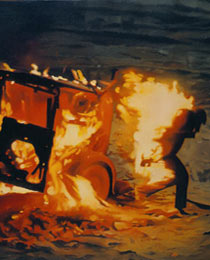
Intransigent contradiction abounds in the work of Vija Celmins. But it does so subtly. The guns, exploded planes, and burning cars have the soft edges of supple fabric. While she culls some of her images from public archives – newspapers and television news sequences – they bear the utmost sense of psychological privacy. The blazing craft in “Burning Plane” (1965) pops with a precision of combustion and photographic realism mixed, while the grisaille in which it is rendered casts a cooling pall over the image.
This small, focused, and poignant retrospective of Celmin’s early paintings shows the artist transitioning from AbEx-inspired internal probing to the outward dissection of mass cultural production. Three sculptural objects on view, two small painted houses, “House #1” and “House #2,” and an impossible toy, “WW II Puzzle Toy,” all from 1965, further link Celmins to surrealist precedent. The fur-lined interior of “House #1” is a clever paean to Meret Oppenheim’s fur-lined teacup of 1936.
